Start Licensing’s Ian Downes spots some great examples this week of brands working collaboratively with well-chosen partners to increase reach and attention in the marketplace.
It is always interesting to see how licensing helps bring brands together and also how it helps brands explore new opportunities.
Licensing is a great way for brand owners to try new things. It can also be used to surprise consumers and retailers.
With this thought in mind I was interested to read about Heinz developing a pasta sauce in collaboration with The Godfather. A Heinz spokesperson talked about the thought process behind the product: “This unexpected yet iconic collaboration is set to unleash excitement and disruption in the pasta sauces category, whether you’re a long-time fan of The Godfather or just looking for a new great tasting pasta dish.”
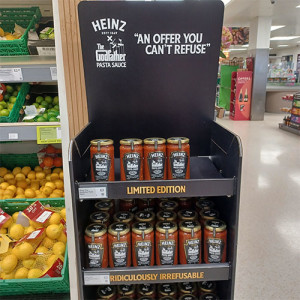 Having read about the product it was good to see it in retail – actions speaking louder than words! I spotted the product in a Waitrose shop presented in a branded FSDU. The FSDU was sited in the fresh produce area – I guess helping consumers to ‘build’ their meal around the sauce. It was a very effective piece of in-store theatre and I saw a number of consumers stopping to look at the product – and buy it. It certainly disrupted the category and from Heinz’s point of view I am sure it has delivered some new consumers and equally importantly encouraged some lapsed consumers to return to the brand or category.
Having read about the product it was good to see it in retail – actions speaking louder than words! I spotted the product in a Waitrose shop presented in a branded FSDU. The FSDU was sited in the fresh produce area – I guess helping consumers to ‘build’ their meal around the sauce. It was a very effective piece of in-store theatre and I saw a number of consumers stopping to look at the product – and buy it. It certainly disrupted the category and from Heinz’s point of view I am sure it has delivered some new consumers and equally importantly encouraged some lapsed consumers to return to the brand or category.
As well as being sold in retail, the product is available via the Heinz To Home direct to consumer site. The site allows consumers to get products delivered direct from Heinz and it features a number of special edition products. It also allows consumers to buy personalised products tapping into the gift market while helping to build the consumer connection with the brand. It is interesting to see brands like Heinz developing a direct to consumer platform. It is probably a direction of travel that other brands will take – this sort of development should open more doors to licensing and special edition products.
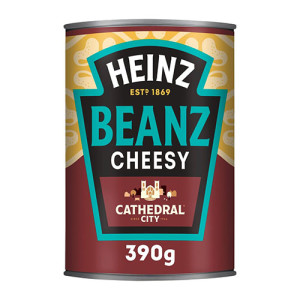 Indeed another brand tie in is featured on the site – Heinz Cheesy Beanz – flavoured with Cathedral City cheese. A blending of two much loved brands. I actually tried to purchase the product online but initially I couldn’t as it was out of stock. Heinz took my details and emailed me when the product was back in stock. I bought some as a result of the message. I thought this was a great example of a brand managing its relationship with their consumers proactively. Working with Cathedral City gave Heinz access to a well known and trusted brand which in turn helped it develop a fresh narrative for the consumer communications. The fact it is only available for a limited time period helps create momentum as well. It also helps that it is a great product that delivers a great taste experience.
Indeed another brand tie in is featured on the site – Heinz Cheesy Beanz – flavoured with Cathedral City cheese. A blending of two much loved brands. I actually tried to purchase the product online but initially I couldn’t as it was out of stock. Heinz took my details and emailed me when the product was back in stock. I bought some as a result of the message. I thought this was a great example of a brand managing its relationship with their consumers proactively. Working with Cathedral City gave Heinz access to a well known and trusted brand which in turn helped it develop a fresh narrative for the consumer communications. The fact it is only available for a limited time period helps create momentum as well. It also helps that it is a great product that delivers a great taste experience.
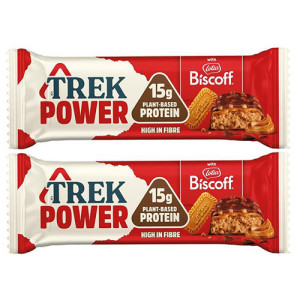 Heinz and Cathedral City are not the only brands joining forces in the FMCG world at the moment. I noticed that Trek has teamed up with biscuit brand Biscoff to launch a co-branded protein bar. Biscoff is a brand that seems to have enjoyed a surge in popularity recently and has explored a range of brand extensions including a Biscoff spread. It has been reported that the Trek team surveyed 60,000 Trek customers and found that 84% of those surveyed indicated that they would buy a Trek Biscoff bar.
Heinz and Cathedral City are not the only brands joining forces in the FMCG world at the moment. I noticed that Trek has teamed up with biscuit brand Biscoff to launch a co-branded protein bar. Biscoff is a brand that seems to have enjoyed a surge in popularity recently and has explored a range of brand extensions including a Biscoff spread. It has been reported that the Trek team surveyed 60,000 Trek customers and found that 84% of those surveyed indicated that they would buy a Trek Biscoff bar.
I am sure this gave both brands the confidence to take this development forward. It is also another example of how brand partnerships can help brands build their relationship with consumers – those surveyed will I am sure have enjoyed being asked their opinion. It also creates great data to use with retailers and, of course, delivers an innovative new product to retailers which is a ‘first’ in the category. Rather like the Heinz Cathedral City partnership, this development is a great example of what well crafted partnerships can deliver for brands. Of course, a key here is a good fit between the brands and a product that delivers on taste.
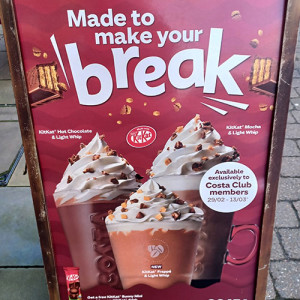 This sort of thing is not just confined to supermarkets. Coffee shops seem to be embracing special editions and flavours more these days. Costa Coffee is currently selling a KitKat Hot Chocolate & Light Whip and a KitKat Mocha & Light Whip. These products are available for a limited time period only and available ‘exclusively’ to Costa Club members only. Again the motivation for these kind of activations seems to be create customer engagement and give consumers a ‘new’ reason to visit Costa.
This sort of thing is not just confined to supermarkets. Coffee shops seem to be embracing special editions and flavours more these days. Costa Coffee is currently selling a KitKat Hot Chocolate & Light Whip and a KitKat Mocha & Light Whip. These products are available for a limited time period only and available ‘exclusively’ to Costa Club members only. Again the motivation for these kind of activations seems to be create customer engagement and give consumers a ‘new’ reason to visit Costa.
The coffee retail market is crowded and competitive. Products like these KitKat ones help Costa stand out from the crowd and, of course, leverage the pulling power of a well established brand like KitKat. For KitKat it helps reinforce the brand attributes, while broadening distribution. It is also a great way of the brand entering new categories. It creates an opportunity to develop these categories further in the future and also showcases the brand’s creative potential to other partners. I also think brands that are working in this way are also showing that they are brands that are forward thinking and not standing still. It must be tempting to settle for the status quo at the moment.
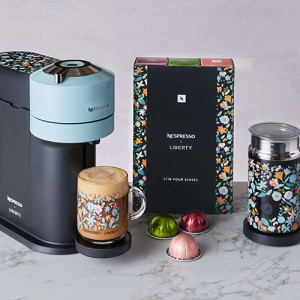 Another great example of a ‘I didn’t see that coming’ collaboration that I spotted this week is one between Liberty and Nespresso. I saw this promoted in the Waitrose magazine. The Nespresso x Liberty partnership is described as “… a collaboration designed to stir the senses”.
Another great example of a ‘I didn’t see that coming’ collaboration that I spotted this week is one between Liberty and Nespresso. I saw this promoted in the Waitrose magazine. The Nespresso x Liberty partnership is described as “… a collaboration designed to stir the senses”.
Liberty has created an exclusive hand-drawn pattern that blends Liberty’s signature style with design elements that help tell the Nespresso story for example featuring the likes of coffee blossoms in the design. The pattern is being used on a Nespresso machine, a milk frother and a mug. Like the other partnerships highlighted earlier this collaboration allows Nespresso to deliver a story to consumers that shines a light on key brand attributes. The product will be sold in Nespresso boutiques, online and for a limited time period in Liberty itself.
Overall this partnership also delivers a retail moment for both partners which is a useful way of driving sales. The range is stylish and makes great use of Liberty’s heritage.
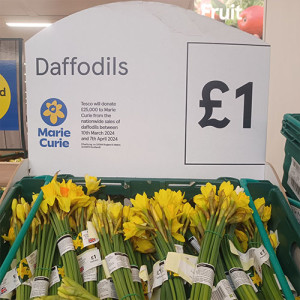 It is also good to see retailers using their space and platform to support charities, particularly when they do it in a clever way. Tesco is currently supporting the Marie Curie charity by pledging to donate £25,000 to the charity from the sale of fresh daffodils in-store in March. The partnership is well communicated by signage in store which features the Marie Curie name and logo – the logo is a daffodil hence the promotional link. A very simple but effective partnership. I am sure it is a model that could be adapted for and by other charities. Tesco’s pledge is something that I’m sure has been well received by consumers. Retailers have recognised that they can help their communities by supporting campaigns like this.
It is also good to see retailers using their space and platform to support charities, particularly when they do it in a clever way. Tesco is currently supporting the Marie Curie charity by pledging to donate £25,000 to the charity from the sale of fresh daffodils in-store in March. The partnership is well communicated by signage in store which features the Marie Curie name and logo – the logo is a daffodil hence the promotional link. A very simple but effective partnership. I am sure it is a model that could be adapted for and by other charities. Tesco’s pledge is something that I’m sure has been well received by consumers. Retailers have recognised that they can help their communities by supporting campaigns like this.
A common theme in my Looking Out this week has been that brands are recognising that, by working collaboratively with well-chosen partners, they can increase their reach and grab more attention in the marketplace. In challenging times working in partnership can bring security and create a degree of certainty. It is probably a good moment to pitch the idea of licensing partnerships to brand managers – there are certainly some intriguing and high profile examples to share with them at present.
Ian Downes runs Start Licensing, an independent brand licensing agency. His Twitter handle is @startlicensing – he would welcome your suggestions for what to look out for.































